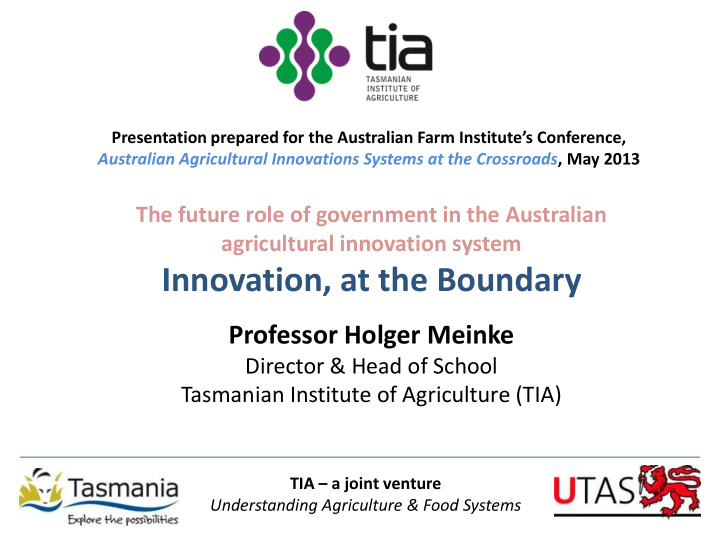



Presentation prepared for the Australian Farm Institute’s Conference, Australian Agricultural Innovations Systems at the Crossroads , May 2013 The future role of government in the Australian agricultural innovation system Innovation, at the Boundary Professor Holger Meinke Director & Head of School Tasmanian Institute of Agriculture (TIA) TIA – a joint venture Understanding Agriculture & Food Systems
Installing the Midlands Water Scheme Distribution Pipeline at Tunbridge (R. Grant, ABC)
Tasmania’s Deputy Premier Bryan Green and Federal Member for Bass Geoff Lyons opening the expanded Winnaleah Irrigation Scheme in Tasmania's North East which doubles the amount of reliable water available to local farmers. Tas Govt
For innovation to occurred, societies and communities must show • a readiness to be disrupted • a fundamental inquisitiveness • a degree of cultural aspiration
Chericbaker/Flickr
Rice farmers inspecting their collectively managed rice field in Phu Tho Province, Vietnam.
New industrial complex under development in the near distance
Vietnam now exports 43 million t of rice annually – 10% of global production
Graduation at the Temple of Literature, Hanoi
… the process that translates knowledge into economic growth and social well- being. … encompasses a series of scientific, technological, organisational, financial and commercial activities .
Innovation systems … … are networks of organizations, enterprises, and individuals focused on bringing new products, new processes, and new forms of organisation into economic use, together with the institutions and policies that affect their behaviour and performance World Bank, 2006
… encompasses a series of scientific, technological, organisational , financial & commercial activities .
Matching scientific knowledge with the nature of the problem Cause/effect Research goals Decision making Disciplinary, reductionist Control, solve well Improving water use efficiency on-farm through Level I Clear, deterministic to provide solutions to defined problems with the introduction of a higher yielding, more efficient clearly defined goals obvious outcomes variety Level II Level III Derived from Allenby & Sarewitz (2010) – The Techno-Human Condition
Matching scientific knowledge with the nature of the problem Cause/effect Research goals Decision making Disciplinary, reductionist Control, solve well Improving water use efficiency on-farm through Level I Clear, deterministic to provide solutions to defined problems with the introduction of a higher yielding, more efficient clearly defined goals obvious outcomes variety Interdisciplinary, Adaptive, seek consensus systems to create on ways to manage Level II Complex, emergent Optimising the use of limited water resources options for addressing reasonably well across enterprises of a farming operation contended goals understood situations Level III Derived from Allenby & Sarewitz (2010) – The Techno-Human Condition
Matching scientific knowledge with the nature of the problem Cause/effect Research goals Decision making Disciplinary, reductionist Control, solve well Improving water use efficiency on-farm through Level I Clear, deterministic to provide solutions to defined problems with the introduction of a higher yielding, more efficient clearly defined goals obvious outcomes variety Interdisciplinary, Adaptive, seek consensus systems to create on ways to manage Level II Complex, emergent Optimising the use of limited water resources options for addressing reasonably well across enterprises of a farming operation contended goals understood situations Seek consensus on issues, Design governance & robust institutional Unforeseeable shifts systems capable of responses (ways of Introducing irrigation on a large scale as a Level III with no definable consensus on ill-defined organising) to anticipate transformational technology that will alter not boundaries and highly contended future conditions despite only farming operations, but the fabric of rural goals persistent uncertainty communities in a region Derived from Allenby & Sarewitz (2010) – The Techno-Human Condition
Matching scientific knowledge with the nature of the problem Cause/effect Research goals Decision making Disciplinary, reductionist Control, solve well Level I Clear, deterministic to provide solutions to defined problems with clearly defined goals obvious outcomes Interdisciplinary, Adaptive, seek consensus systems to create on ways to manage Level II Complex, emergent options for addressing reasonably well contended goals understood situations Seek consensus on issues, Design governance & robust institutional Unforeseeable shifts systems capable of responses (ways of Level III with no definable consensus on ill-defined organising) to anticipate boundaries and highly contended future conditions despite goals persistent uncertainty Derived from Allenby & Sarewitz (2010) – The Techno-Human Condition
When can science compel policy action? Value consensus Low High Science used to select between Science used to select preferred Low well defined options option Information may reduce ambiguity There is clear agreement about about what the options are, but what the options are, why action does not help to select between should be taken and what the best them course of action is Uncertainty Science used to justify divergent Strong commitment to act, but High approaches not sure how. More science leads to increasing Policy may decide to act ahead of number of contended options, science with varying paralysing decision processes. consequences. Science can be used to build governance systems for managing societal change. Source: Pielke (2007) – The Honest Broker, Ch2
Key roles for organisations involved in innovation systems • Boundary work : Creating institutional arrangements that strongly engage science with society and policy; • Governing outcomes : Empowering outcome-focused institutions through adaptive governance processes that value impact; • Earn a ‘social license’ : Encouraging critical thinking and debates about public goods, values and market failure; science is important, but not sufficient; • PAR as an important, policy-relevant process : Designing innovations systems that include robust approach to participatory planning and development; • Effective decision-making : Acknowledging that ‘perfect knowledge’ is unobtainable – and unnecessary. Chance, ignorance and indeterminacy cannot be eliminated, but must be taken into account
Thank you
Recommend
More recommend